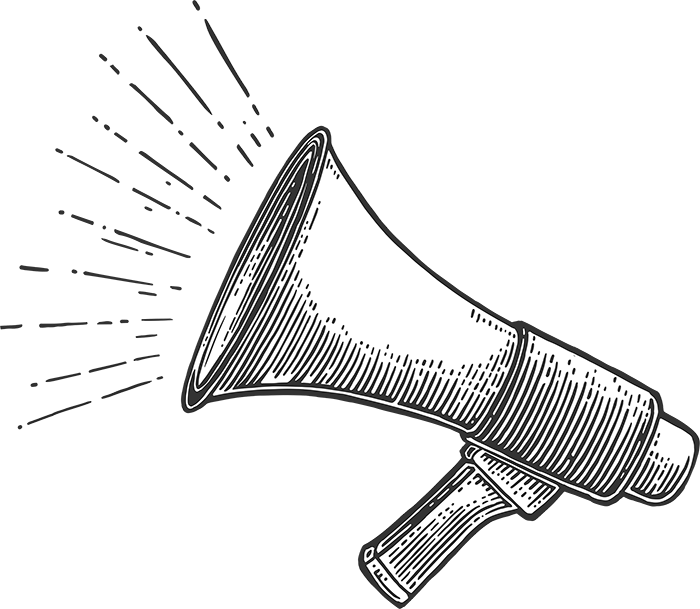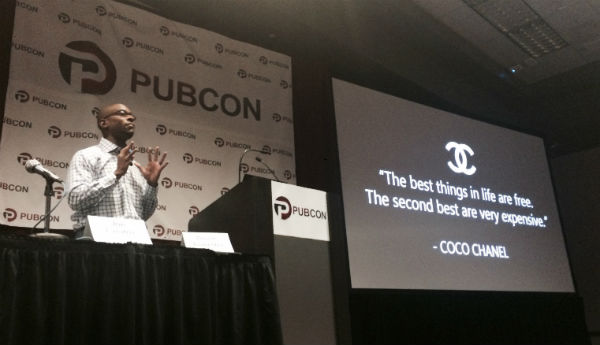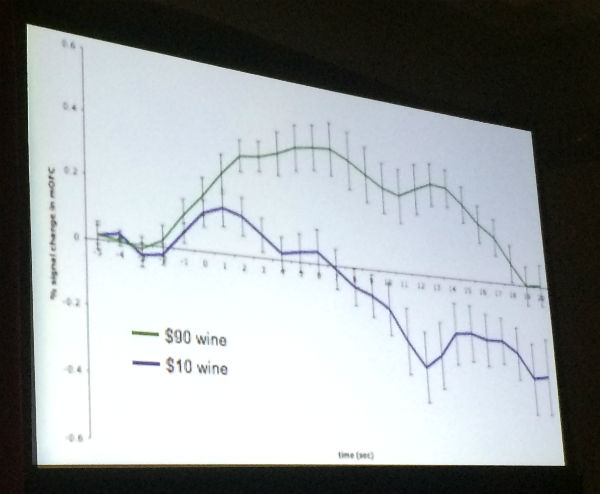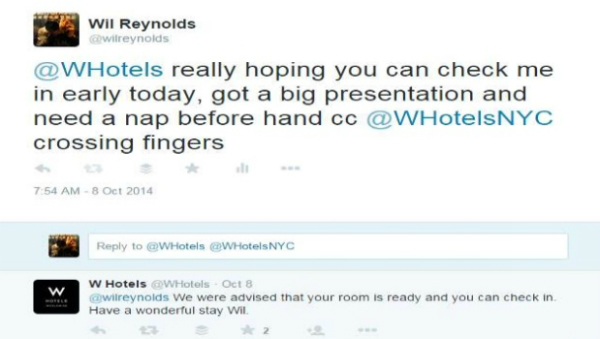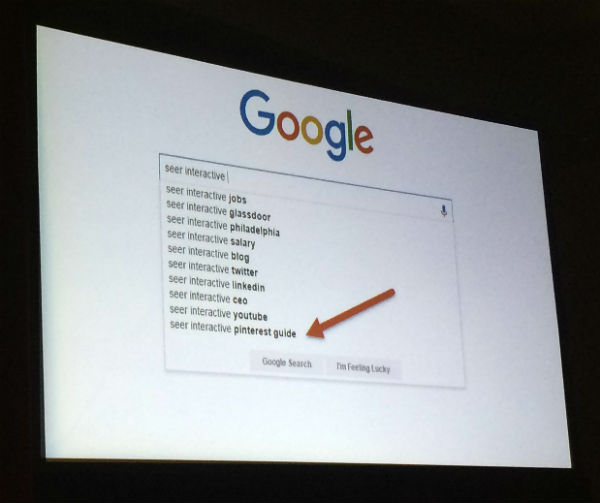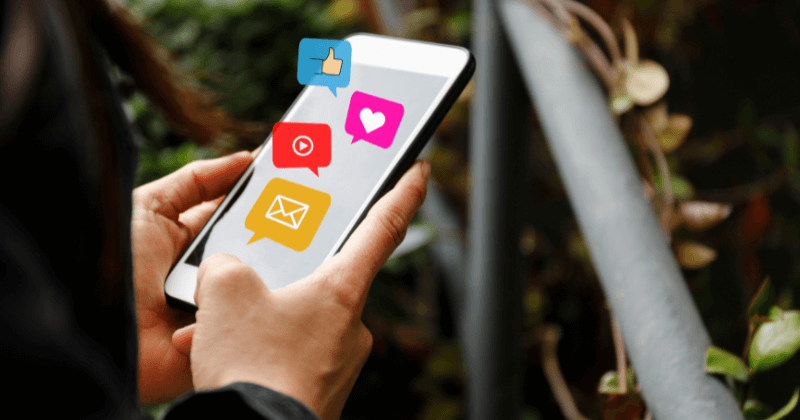The High Cost of Free Traffic: Pubcon Keynote by Wil Reynolds
In this session at Pubcon Las Vegas, keynote speaker Wil Reynolds (@wilreynolds), founder of SEER Interactive, talks about why it’s vital for brands to be creating “content that’s worth paying for.” Follow along in his slide deck below as you read what Reynolds said in this liveblog.
The High Cost of Free Traffic
In the last six months, Wil tried to achieve SEO results with paid search tactics.
In Las Vegas, we’re probably all staying at a hotel. Look for a “Las Vegas hotel” SERP and find the lonely, sidelined organic results.
Guess the CTR of the No. 1 spot? It’s impossible. (See Reynolds’s 25+ Reasons why predicting CTR from Rankings is Impossible.)
He introduces the idea of Diminishing Margin Utility with an example. The first hot dog is delicious. The 50th hot dog, not so much. When you try so hard to achieve a top ranking and find out that you’re getting a 1.574 click through rate and the No. 4 result has a 1.4 CTR … that’s diminishing margin value.
It is a paid world. A lot of us will say that Google only cares about paid ads, but remember that Facebook is not much different. Users don’t see organic content. Your traffic isn’t free. The idea of organic being cheap is wrong. Re-do your equations, because we’ve all basically been tricked. Start looking at the CTR of the keywords you have highly ranked, and that should be what helps you determine how much time and effort to put into these things.
The question is not whether or not to go into paid. It is: What are you building that is worth paying for people to see?
What have you built that you’d pay for people to see? In a paid world, if you’re not writing content that’s worth paying for, you just have a slice of organic that’s not worth seeing.
The total audience for your content is greater than the searching audience for your content. Who here searched for “SEO conference” before they arrived here at this SEO conference? Maybe 4 out of 2,000?
What does that mean for the marketer/SEO focusing on organic only? Good luck. It’s shrinking. This is the largest Pubcon ever, and the business is growing without people searching to get here. This is a reminder that well-executed organic is costly.
If you’re running a ranking report and not looking at the search results page, then you’re not going to see the direct answer boxes and other SERP features that compete with organic spots.
Wil’s not saying to give up on organic. Fight the good fight. Pivot.
First of all, we have to agree on what’s great content.
Example 1: Serious Eats
Look at the Serious Eats definitive guide to steak: http://www.seriouseats.com/2014/12/food-lab-guide-to-prime-rib.html
They’ve inserted things that are relevant that help cook a better steak (such as Q: What tools will I need?). The content goes on and on, and you learn something. For instance, did you know a Delmonico steak is a rib eye? Read the article (sorry, vegetarians) and now you know. How do you feel about SeriousEats.com now? Would you go there again?
It’s worth mentioning here that this story started with Wil looking at Twitter and seeing a post by Rand Fishkin linking to a Serious Eats article on the best way to grill steak. This didn’t start with a search.
Think of the psychology of what happens. He reads the article. He cooks an amazing steak. People compliment him on it. He feels better about himself. He connects that feeling with Serious Eats. Now the brand is causing him to go back when he wants to cook salmon.
Example 2: Airbnb
Search for “Airbnb London” — they’re destroying vacation rental keywords because people aren’t searching for that generic keyword. Check Google Trends; you’ll see that “vacation rentals” is going down and “Airbnb” queries are going up.
Make People Feel Good about Themselves
Reynolds quotes from Buffer (@buffer): “People don’t buy products. They buy better versions of themselves.” (See the full article on Buffer Social here: bit.ly/why-people-buy.)
Think about whether your content is making people feel better about themselves and high five-worthy. To compare to the Serious Eats example, the WikiHow “How to Grill a Steak” article is dense with ads. How does that make you feel? Reynolds says, “I’m being sold to. WikiHow doesn’t care about me and making me a better griller.”
How much time have you spent on what makes people buy? Reynolds admits that if you look at how much time he’s invested in figuring out how search engines work and how much time he’s spent understanding why people buy, “it’s a travesty.” Instead of trying to deconstruct the search engine algorithm, now he’s looking at psychology and what makes people happy. Books like “Switch” help him see why people buy.
How Feeling Good (about a Brand) Affects People
Let’s talk about the brain. The medial orbital frontal cortex lights up when people see brands they recognize. While doing a test on brain activity using an MRI looking at this part of the brain, researchers gave people wine. They told them it was $90 wine. They then gave them wine they said was $10/bottle. Researchers found that people feel much better about themselves when they think they’re drinking the good stuff.
Example 3: Michelin
There’s a book about content marketing written in 1900. The Michelin company in 1900 sold more tires with content. The company realized that as people wore down their tires, they’d need to buy new tires. And they knew that branding could cause people to buy stuff. They thought that if they could get the chauffeur to drive more, they’d make more tire sales. So Michelin launched a series of books: The Michelin Guide to Restaurants in the French Countryside. (Michelin-rated chefs are a result of this project.) The company knew that if they gave these books to more chauffeurs, they’d drive the French countryside more, they’d give their clients an experience of new restaurants, and those clients would feel special telling their friends about new, exclusive places they’d dined. (Reynolds heard this story from Kieran Bass (@kieranbass).
He’s asking clients today: Do I have your trust to spend 3–5 percent of your marketing budget on getting people to love your brand? When they do a good job with that, the next year he asks clients for 10 percent.
Example 4: W Hotels
Business executives who travel, Reynolds shares how W Hotels turned an empty room into a PR opportunity. On his way to New York recently, he had this exchange on Twitter:
When he arrived at the hotel for early check-in, the front desk clerk told him no rooms were available. But someone else walked up and said, “Mr. Reynolds? Your room is ready.” The social media team had taken care of his request by upgrading him to a suite. Later, Reynolds shared the story in an article for Entrepreneur magazine. PR win.
Example 5: Amazon
Reynolds quotes, “The greatest trick the devil ever pulled was convincing the world he didn’t exist.” Amazon founder and CEO Jeff Bezos “is the best SEO” despite his stated dislike of search engine optimization. Amazon has a 74 percent conversion rate. “Pay with Amazon” in your meta description is going to give people a signal that you have easy checkout.
The best innovations he’s ever thought of have come when he’s taken the easy solution off the table. Take the website out of the equation. Remove friction. For example, Amazon has launched Dash buttons — a 10x idea that delights customers and removes friction.
Remove Friction, Refresh Content
Look for where your business is making it harder for people to engage with you and fight to remove it. How would you improve the rankings of your business if someone told you that you couldn’t change your website? Take that easy solution off the theoretical table, and you’ll come up with something innovative and different.
Go BIGGER. He’s having his company write less content and refresh old content. Look at your analytics and see how old the top visited content is. Look at that content and ask yourself how it can be freshened up. “Write less new stuff; go back and make sure the old stuff is still valuable.”
Example 6: SEER’s Best Content
Reynolds’s Screaming Frog guide ranks No. 1, but it’s out of date because Screaming Frog has a newer version. So what if he gets the click? The content won’t solve the visitor’s problem.
Think about this. His company created one piece of content — a guide for helping clients get more from Pinterest. Creating it took:
- 11 people
- 200–300 hours
- $900 in promotion
- 0 link building
- 0 outreach
It is now the most searched guide with his company brand name. TIP: Do the alpha character test with your brand name at the front of the search box to see if anyone’s looking for your branded content.
A search on Topsy reveals that tons of people are resharing that guide. Someone even thanked Wil for an ad he ran with the content. When does anyone ever thank people for ads?! When you have really great content.
More results: The guide was included in the Moz Top 10. The guide ranked on the first page of Google. An email from a trusted source improved the guide’s ranking. When SEER first launched this guide, there were four guides ranking. They’re moving up and expect to bump off even Pinterest’s own guide in the rankings.
Questions:
- Name the companies you think show up for “SEO 101”.
- Which result is the least likely to show you pop-ups?
- Who loves pop-ups?
Serious Eats is slicing and dicing the golden cow. They dominate SERPs for things like “rib eye vs.” and “best steak for.” When you’ve spent hundreds of hours creating a good piece of content, it’s easy to slice and carve off more content like it. Subsequent content gets easier when you build one thing that’s great.
‘Make Less Content’ and Other Tips
He wants us to commit to making less content. Reap the later organic benefits. Write something that makes people start searching for the brand after reading something else that made their life better.
Reynolds recommends “Nudge” as a great book to read. Seek to understand the audience that would be leveled up if they found your content. Remember, paid is your friend. You can target your audience in a very granular way. You can exclude and negative match keywords, and you can target net worth, relationship status, and interests.
Use Keywordtool.io — Drop in your brand name and see what people are searching for.
If your content was removed from the web, would anyone miss it?

One Reply to “The High Cost of Free Traffic: Pubcon Keynote by Wil Reynolds”
Fantastic article! I actually think this article describes what search engines should do, find the content that solves the reason for the search! We have definitely come a long way from worthless black-hat seo serp domination, but I still think there is more work to be done. But Google and others are getting there!
LEAVE A REPLY
